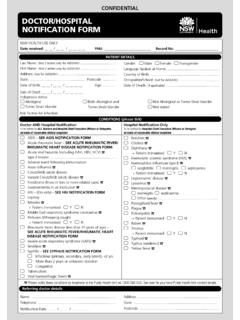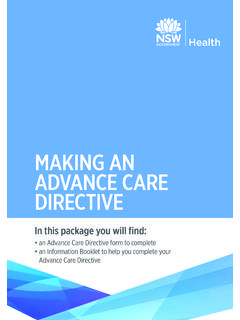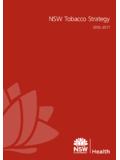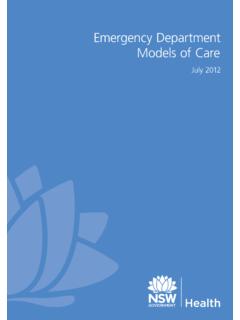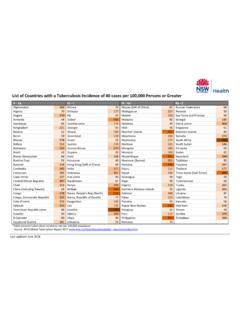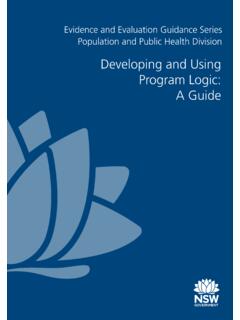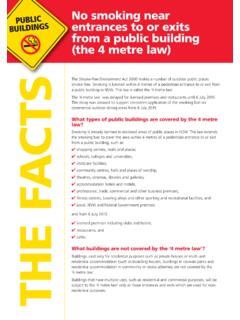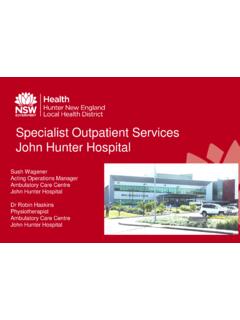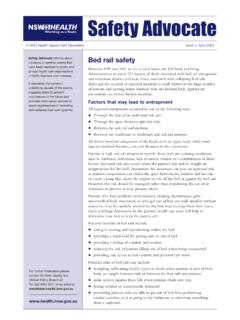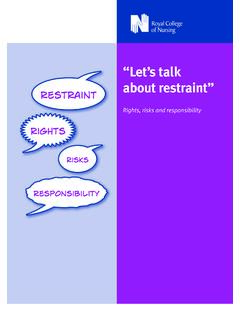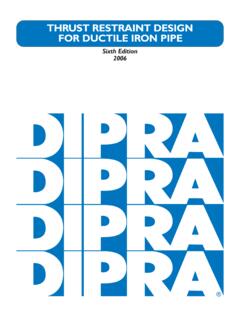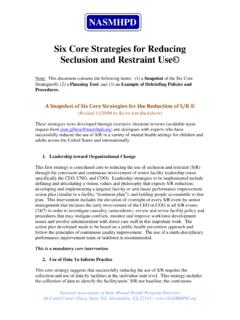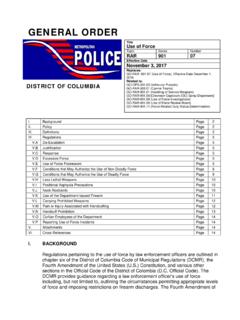Transcription of To view any policy document as ... - Ministry of Health
1 To view any policy document as published on the policy Distribution System click the link on the policy number in the table below. CHAPTER 13 MENTAL Health TABLE OF CONTENTS CHAPTER 13 MENTAL Health PD/IB/GL NUMBER Seclusion and Restraint in NSW Health Settings PD2020_004 Aggression, Seclusion & Restraint in Mental Health Facilities Guideline Focused Upon Older People GL2012_005 HEALTHPLAN Mental Health Services Supporting Plan GL2012_006 Clinical Care of people who may be suicidal PD2022_043 Sexual Safety Responsibilities and Minimum Requirements for Mental Health Services PD2013_038 Sexual Safety of Mental Health Consumers Guidelines GL2013_012 The NSW Aboriginal Mental Health and Wellbeing Strategy 2020-2025 IB2021_002 NSW Older People s Mental Health Services SERVICE PLAN 2017-2027 GL2017_022 Specialist Mental Health Services for Older People (SMHSOP) Community Model of Care Guideline GL2017_003 Discharge Planning and Transfer of Care for Consumers of NSW Health Mental Health Services PD2019_045 Drug and Alcohol Psychosocial Interventions Professional Practice Guidelines GL2008_009 Mental Health Clinical Documentation Guidelines GL2014_002 Physical Health Care within Mental Health Services PD2017_033 Physical Health Care for People Living with Mental Health Issues GL2021_006 SAFE START Strategic policy PD2010_016 SAFE START Guidelines.
2 Improving Mental Health Outcomes for Parents & Infants GL2010_004 School-Link Initiative Memorandum of Understanding PD2010_020 Electroconvulsive Therapy (ECT) ECT Minimum Standard of Practice in NSW PD2011_003 Children and Adolescents with Mental Health Problems Requiring Inpatient Care PD2011_016 Chief Psychiatrist Panel Review of Complex Mental Health Treatment Plans PD2011_055 Monitoring Clozapine-induced Myocarditis GL2022_011 Forensic Mental Health Services PD2012_050 Mental Health Triage policy PD2012_053 Call Handling Guidelines for Mental Health Telephone Triage Services GL2012_008 Management of Patients with Acute Severe Behavioural Disturbance in Emergency Departments GL2015_007 Psychiatric Emergency Care Centre Model of Care Guideline GL2015_009 Older People s Mental Health (OPMH) Acute Inpatient Unit Model of Care GL2022_003 Engagement and Observation in Mental Health Inpatient Units PD2017_025 Adult Mental Health Intensive Care Networks PD2019_024 Supporting Young People During Transition to Adult Mental Health Services GL2018_022 Use of Audio-Visual Link for Mental Health Assessments under the Mental Health Act 2007 IB2022_007 Forensic Patient Electronic Monitoring IB2022_008 Last updated December 2022 13.
3 MENTAL Health SECLUSION AND RESTRAINT IN NSW Health SETTINGS (PD2020_004) PD2020_004 rescinds PD2012_035 and PD2015_004 policy STATEMENT NSW Health s commitment to preventing seclusion and restraint aims to improve safety for people accessing public Health services and staff. This policy Directive outlines the principles, values and procedures that underpin efforts to prevent, reduce and, where safe and possible, eliminate the use of seclusion and restraint in NSW Health settings. SUMMARY OF policy REQUIREMENTS This policy applies to all NSW Health staff working in all NSW public Health settings. Seclusion and restraint must only be used as a last resort, after less restrictive alternatives have been trialled or considered. The principle of least restrictive practice is common across all settings. It means NSW Health staff will maximise a person s choices, rights and freedom as much as possible while balancing healthcare needs and safety for all.
4 The safety of staff must be maintained at all times, including during the planning, initiation, undertaking, monitoring and cessation of the seclusion and restraint of a person. NSW Health services must have systems that: minimise and, where possible, eliminate the use of seclusion and restraint govern the use of seclusion and restraint in accordance with legislation report use of seclusion and restraint to the governing body. All local Health districts, specialty Health networks and NSW Ambulance must have local procedures in place that are consistent with the principles and requirements identified in this policy by July 2020. NSW Health districts and networks and NSW Ambulance must develop, implement and annually review a service level action plan to prevent, reduce and, where safe and possible, eliminate the use of seclusion and restraint, in collaboration with staff, those accessing Health services, carers and families. Seclusion and Restraint in NSW Health Settings: Procedures.
5 1 BACKGROUND About this document NSW Health is committed to minimising and, where safe and possible, eliminating the use of seclusion and restraint. The aim is to maintain and protect the safety of all people accessing services, staff and visitors. It is not unusual for staff or others to raise concerns that safety will be compromised if seclusion and restraint are reduced. Current evidence indicates that reducing seclusion and restraint will minimise physical and psychological harm experienced by people accessing services and staff. This policy aligns with the National Safety and Quality Health Service Standards (2nd edition) requirements for minimising harm. It articulates principles that apply to all NSW Health settings. It describes mandatory requirements and how these are tailored for specific healthcare contexts. Section outlines additional requirements for specific settings. 327(06/03/20) 13. MENTAL Health The principle of least restrictive practice is common across all settings.
6 It means NSW Health staff will maximise a person s choices, rights and freedom as much as possible while balancing healthcare needs and safety for all. This requires leadership committed to: protection of human rights maintaining a safe workplace a just and learning culture a prevention approach to reducing seclusion and restraint respectful behaviours and interactions at all service levels recognising and addressing potentially traumatising or triggering environments and behaviour adequate staffing and resources, including training and supervision collaboration and co-design with those directly affected by the practices of seclusion and restraint. Key definitions NSW Health recognises that language has an impact on people and the use of inclusive and contemporary terms can minimise stigma. This policy is informed by current practice and consultation with people accessing NSW Health services and service providers. Key definitions for seclusion and restraint align with the National Safety and Quality Health Service Standards (2nd Edition).
7 Definitions may vary for legal purposes. Where there is variation, practice must be consistent with applicable legislative definitions and requirements. In some cases, practices that do not meet the policy definition of restraint used in this document will still require appropriate consents. Given the scope of this policy , the words person , people or individuals have been used to refer to anyone accessing NSW Health services 327(06/03/20) 13. MENTAL Health Word/Term Definition Additional notes Acute Sedation Acute sedation is the temporary use of medication to reduce agitation, irritability and ASBD for the purpose of assessment and treatment. Acute sedation is not considered chemical restraint when it allows for assessment to be continued and treatment for the underlying condition to be commenced. NSW Health recognises that acute sedation may be experienced or perceived as coercive by people accessing services, carers, families and others.
8 It is important that this practice is safely managed by expert clinical decision making around the level of sedation and by adherence to current clinical guidelines. The aim is to achieve an appropriate and safe level of sedation quickly with sufficient medication to manage ASBD and to facilitate an accurate assessment and appropriate management of the person s underlying condition. The level of sedation should ensure the person is drowsy but they must be rousable. Acute Severe Behavioural Disturbance (ASBD) Behaviour that puts the person or others at immediate risk of serious harm. This may include threatening or aggressive behaviour, extreme distress and self-harm. Examples of indicators of ASBD may include: aggression, hostility, physical and verbal intimidation, hitting, spitting, cutting, kicking, throwing objects, damaging equipment, using weapons or objects as weapons, and highly disinhibited behaviours, including sexual disinhibition.
9 While behavioural concerns associated with issues such as acquired brain injury, dementia or cognitive impairment may be longstanding, the use of the word acute signals the need to address the behavioural concern now. Carer Carer is used to describe a person who provides ongoing unpaid support to a family member or friend who needs help because of disability, medical condition (terminal or chronic), mental illness or ageing. Carers may support their family member or friend when accessing NSW Health services. Carer is defined under the NSW Carers (Recognition) Act 2010. Consent and information provision to a carer must be in line with the relevant legislation. Depending on legislation, such as Mental Health Act 2007, different terms include: Representative; primary care-giver; primary carer; person responsible; designated carer; principal care provider. Chemical Restraint The use of a medication or chemical substance for the primary purpose of restricting a person s movement.
10 The definition of chemical restraint is a challenging issue. This is partly due to the need to attribute a purpose to the use of the medication. Medication (including PRN) prescribed for the treatment of, or to enable treatment of, a diagnosed disorder, a physical illness or a physical condition in line with current clinical guidelines is not considered chemical restraint. 13. MENTAL Health Least Restrictive Practices Practices that maximise the autonomy, rights, freedom, wellbeing and safe care of the person as much as possible while balancing healthcare needs and safety for all. Environments should be safe, supportive and least restrictive. Staff must not withhold access to spaces or items unnecessarily, unless there are safety reasons for people accessing services, staff and others. Mechanical Restraint The application of devices to a person's body to restrict their movement. This is to prevent the person from harming themselves or endangering others, or to ensure that essential medical treatment can be provided.
